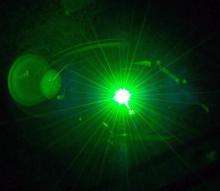Laser beams for superconductivity: Research sheds light on unexpected physical phenomena

A laser pulse, a special material, an extraordinary property which appears inexplicably. These are the main elements that emerge from a research conducted by an international team, coordinated by Michele Fabrizio and comprising Andrea Nava and Erio Tosatti from SISSA, Claudio Giannetti from the Università Cattolica di Brescia and Antoine Georges from the Collège de France. The results of their study have recently been published in the journal Nature Physics. The key element of the study is a compound of the most symmetrical molecule that exists in Nature, namely C60 bucky-ball, a spherical fullerene.
It is well known that this compound, with the chemical formula K3C60, can behave as a superconductor - that is, conduct without dissipating energy - below a critical temperature of 20 degrees Kelvin, i.e. around -253 degrees Celsius.
It has recently been discovered that K3C60 is capable of transforming into a high-temperature superconductor when struck by an extremely brief laser pulse. This material takes on superconductive properties - albeit extremely briefly - up to a temperature of -73 degrees Centigrade, almost 100 degrees above the critical equilibrium temperature. The research just published by the scientists explains the reason for this mysterious behaviour.
K3C60 is a compound in which purely molecular features coexist alongside metallic properties, a characteristic shared by so-called "strongly correlated" materials. According to the theory developed by the researchers in this study, the laser beam creates a high-energy molecular excitation, yet in order to do so it must absorb heat from the low-energy metallic component, which thus cools. As it is specifically the metallic component involved in conduction, its cooling may lead to a superconductivity phase despite the external temperature is higher than the critical temperature.
As the researchers explain: "It is an example of laser cooling, yet with a new operating mechanism which had never been proposed until now. The fact that the laser pulse can transiently change the characteristics of a material is a significant observation. It may offer the prospect of manufacturing electronic devices whose properties change with the use of light, as if it were a switch. Indeed, the ultra-rapid control of materials with light sources is of great current interest for the scientific community and for the possible technological ramifications of these applications."
More information: Andrea Nava et al, Cooling quasiparticles in A 3C 60 fullerides by excitonic mid-infrared absorption, Nature Physics (2017). DOI: 10.1038/nphys4288
Journal information: Nature Physics
Provided by International School of Advanced Studies (SISSA)



















